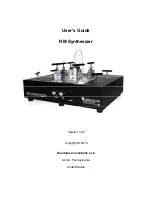
14
CS1x MAIN
OPERATING
MODES
The CS1x has two main operating modes: Performance mode and Multi
Play mode. The chief distinction between each mode is as follows:
• Performance mode is primarily for realtime performance of
Layers. It
has six menus of Edit parameters.
• Multi Play mode is primarily for multitimbral playback of up to 16
Parts when external MIDI devices are connected. It has one menu of
Edit parameters. You can also use the CS1x as a MIDI data input
device for an external sequencer.
Utility mode lets you modify System and MIDI parameters which affect
both Performance and Multi Play mode. (For more information about
Utility mode, see page 40.)
Store mode lets you store your own User Performances and Scenes. (For
more information about Store mode, see page 44.)
Performance
Mode
If you're in a different mode, press the PERFORMANCE button to enter
Performance mode.
In Performance Play mode you can select a Performance from 128 Preset
Performances and 128 User Performances and begin playing.
A
Performance is comprised of up to four "Layers", or AWM2 voices
sounding at once—either playing simultaneously across the length of the
keyboard, or playing independently according to specified key and
velocity ranges.
There are many Performance parameters which you can edit by
offsetting
parameter values—i.e., adding to or subtracting from the values which
are preset for each voice. There are basically two ways to go about offsetting
the parameters—by turning the Sound Control Knobs, or using the Edit
Parameter Rotary Switch and Parameter Value UP/DOWN buttons.
Changing any parameter will automatically engage Performance Edit
mode. (You can easily switch back Performance Play mode by pressing
the PERFORMANCE button or PROGRAM [–]/[+] button.)
ATTACK
AMP EG
RELEASE
ASSIGN 1/DATA
VOLUME
CUTOFF
FILTER
RESONANCE
ASSIGN 2
2
MW/FC
1
SCENE
Turning the Sound Control Knobs will give you direct access to the AMP
EG and FILTER parameters, thus providing analog-style realtime control
over key characteristics of the sound. You can also save up to two
"snapshots" of knob positions in Scenes, which can be instantly recalled
at the touch of a SCENE button.
Another way to edit a Performance is with the Edit Parameter Rotary
Switch and Parameter Value UP/DOWN buttons. These give you control
over both "Common" parameters which affect all Layer voices equally,
and "Layer" parameters which affect individual Layers, or AWM2 voices.
PERFORMANCE
MULTI
DEMO
STORE
UTILITY
TYPE
BANK
P BEND
RANGE
NOTE
SFT
ATK
TIME
ATK
TIME
MASTER
TUNE
TEMPO
ARPEGGIATOR
PERFORM
LEVEL
EFECT
PROGRAM
SYSTEM
MIDI
ASSIGN
PMOD
DETUNE
DCY
TIME
DCY
TIME
KBD
TRANS
SUB
DIVIDE
VOLUME
FMOD
REV
TYPE
CUTOFF
FC
PORTA
VEL
ASSIGN2
LFO
PEG
CHO
TYPE
VARI
EF
VARI
TYPE
SWITCH
VARI
PARAM
TIME
VARI
DATA
MW
FMOD
LIMIT
LOW
TUNE
AEG
FEG
NOTE
SUS
LEVEL
SUS
LEVEL
VEL
CURVE
PAN
CUTOFF
LIMIT
HIGH
REL
TIME
REL
TIME
VEL
FIX
REV
SEND
LIMIT
LOW
AMOD
INIT
LEVEL
TRANS
CH
CHO
SEND
LIMIT
HIGH
PMOD
ATK
TIME
EFFECT
RCV
CH
VARI
SEND
OFFSET
FMOD
ATK
LEVEL
DEVICE
NO
CUTOFF
FILTER
DEPTH
WAVE
DCY
TIME
LOCAL
REZ
PARAM
SPEED
REL
TIME
BULK
DUMP
PERFORM
NAME
POLY/
MONO
ASSIGN1
PARAM
DATA
PHASE
INIT
REL
LEVEL
CTRL
NO
COMMON
LAYER
UTILITY
Edit Parameter Rotary Switch
Parameter Value UP/DOWN Buttons
In Performance mode there are six Edit menus of Common and Layer
parameters which can be accessed via the Edit Parameter Rotary Switch
and modified with the Parameter Value UP/DOWN buttons.
Try changing the voice assignments to each Layer. This is a quick and
effective way to create an entirely new Performance, which you can
easily store as a User Performance.
Assigning voices to the Layers is simple. Choose the Layer (1~4) with the
PART/LAYER [–]/[+] buttons, and select from a variety of AWM2
instrument voices and drum voices using the Bank and Program
Parameters (Layer Edit 4, sixth row from the top).












































